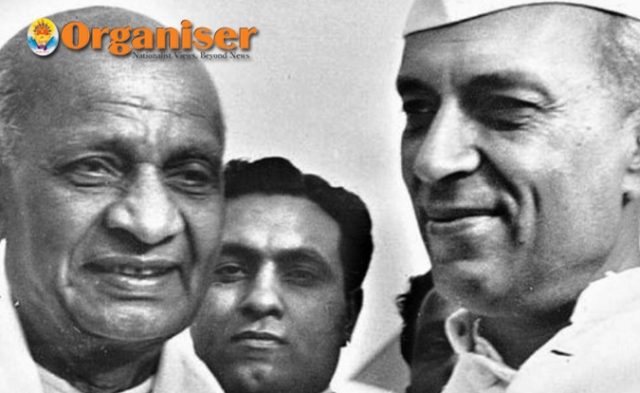
Nehru worked hard to sideline Sardar Patel and Purushottam Das Tandon from Congress, and he was working to split the party as well
Sardar Vallabhbhai Patel had many rivals, who found communalism in his patriotism, and reactionism in his Gandhian and Swadesi ideas. Supposedly Patel’s ‘comrade-in-arms’ Jawaharlal Nehru was his chief rival, and he always worked hard to uproot Patel from the Congress Party.
One knows well that all was not good between Nehru and Patel by the time Mahatma Gandhi was alive. A myth is circulated by Nehruvians that Patel and Nehru were like brothers and Gandhiji’s death erased all their differences. However, the following expose is enough to falsify the claim!
A Confidential CIA report titled ‘Establishment of a “Democratic” Group of Indian Congressmen’, dated November 10, 1950, reports the following: “At Nehru’s suggestion Acharya Kriplani, ex-Congress President and a sharp critic of Sardar Patel, has organised a “democratic” group of Congressmen. Kriplani is being sided by Dr Praffula Ghose, ex-premier of West Bengal, and by some of Gandhi’s faithful lieutenants.”

The report further states, “This group, which Nehru sees as an effective tool against Purushottam Tandon and Vallabhbhai Patel, is strongly opposed to the “corrupt practices” of Patel and his followers. This group also condemns Patel’s communal bias.”

There are two more comments in the CIA Report which says, “The original report is vague as to dates, but the organisation seems to have occurred during or right after the recent Nasik Congress.”
The other comment is, “A Chinese businessman of Calcutta, who made a recent trip to New Delhi, has confirmed that Nehru is moving to organise a new party along progressive-democratic-socialist lines.”
Contextualising the Report
Sardar Patel died on December 15, 1950. Purushottam Das Tandon was the President in the 56th session of Indian National Congress, on September 21-22, 1950. The CIA report was filed on November 10, 1950.
A Confidential CIA report titled ‘Establishment of a “Democratic” Group of Indian Congressmen’, dated November 10, 1950, reports the following: “At Nehru’s suggestion Acharya Kriplani, ex-Congress President and a sharp critic of Sardar Patel, has organised a “democratic” group of Congressmen. Kriplani is being sided by Dr Praffula Ghose, ex-premier of West Bengal, and by some of Gandhi’s faithful lieutenants.”
Anyone who knows the history of Indian National Congress and the partisan which inflicted the party is well aware of the fact that Nehru claimed to have been struggling with the reactionary forces within the Congress. Nehru claimed himself as ‘democratic, secular, and progressive’ while those who tend to disagree with him, such as, Patel and Purushottam Das Tandon were declared ‘communal, reactionary and conservative.’
The seeds of this radical partisan were sown by Nehru himself. The reason was simple! Nehru thought that the party was being hijacked by the dominant ‘Right Wing’, of which supposedly Patel and Tandon were the main leaders.
The first tussle was in 1948 when Purushottam Das Tandon, backed by Sardar Patel defeated Acharya Kripalani, whose candidature was supported by Jawaharlal Nehru. Tandon, however, resigned a few months later as some senior leaders including Nehru declined to work in the Congress Working Committee.
However, the same Kriplani who enjoyed Nehru’s backup until Patel died, was shoed away from the Congress Party in 1951. In June 1951 a few dissidents led by Kriplani founded the Kisan Mazdoor Praja Party. Its two leaders: Prafulla Ghose and Tanguturi Prakasam, had been Chief ministers of West Bengal and Madras respectively.
In short, Nehru didn’t alone backstab Patel; he was unfair to everyone who declined to succumb under his dominant persona. Unfortunately, Nehruvians would never narrate these stories; they will never accentuate the above facts!
-Shaan Kashyap
Courtesy: Organiser














